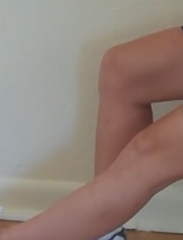The sensation of tightness behind knee is quite common. It can be mild or be severe and a symptom of some underlying condition.It may sometimes occur suddenly, often because of an injury, or it may occur slowly over a period of time, signifying some type of knee problem.
Some patients may sometimes suffer from knee pain that is achy, while others may experience sharp and acute pain at the back part of the knee, while some others may experience swelling that limits the motion of the knee.
Mild cases of tightness behind knee may resolve on its own, while moderate to severe cases may require physical therapy, medications, and even surgery. Doctors may also recommend certain exercises to ease the pain and discomfort.
Causes of tightness behind knee
Some of the common causes of tightness behind knee are listed below:
- Baker’s cyst: It is one of the most common causes of tightness behind knee and is marked by a lump at the back of the knee. It may occur due to fluid buildup at the back of the knee; inflammation or swelling or the fluid-filled sac or popliteal bursa behind knee; or a torn cartilage. Baker’s cyst has close links with arthritis as the arthritis fluid often leads into the bursa and makes it swollen. It may also occur slowly after a blow or injury to the back of the knee.
- Additional symptoms include swelling or a swollen water-balloon-like bump, pain at the back of the knee, and increased discomfort with walking, straitening or bending knee, and kneeling.
- Treatment involves treating the underlying causative disorder, ice packs to reduce swelling, aspiration or draining knee with needle or syringe, exercises, yoga, lots of rest, electrotherapy, injections, and/or surgery in severe cases. Complete recovery occurs in a few months. Improper treatment of Baker’s cyst increases the risk of a reoccurrence.
- Hamstring strain/injury: A common sports injury, a pulled hamstring is marked by a tear in any of the hamstring muscles present at the back part of the thigh. Hamstring strain/tear occurs suddenly due to an injuryand is often triggered by fatigue, poor conditioning, muscle imbalance, or tightness.
- In addition to tightness behind knee, patients may also experience thigh muscle injury or strain, general pain or achiness behind knee at the attachment point of the tendon and the knee bone, and sharp pain at the back of the knee due to sudden motion. Sudden deceleration or acceleration during movements and bending the leg may worsen the pain.
- Treatment involves massage, PRICE, tubigrip, exercises, yoga, and/or surgery. Full recovery occurs in about 6 to 12 weeks.
- Knee sprain: It refers to a tear or overstretching of any of the ligaments occurring in the knee. It is usually caused due to force exerted across the knee or sudden or rapid twisting movements.Knee sprain is categorized into 3 grades as per the severity and extent of the damage.
- Patients may experience tightness behind knee, bruising, pain, reduced knee or leg movement, swelling, and giving way of the legs. Depending on the intensity of the knee sprain, any kind of knee motion or physical activity can aggravate the condition.
- Treatment involves PRICE, tubigrip, exercises, and knee brace. As per the extent and grade of knee injury, full recovery may occur in 2 weeks to three months.
- Meniscus tear: It refers to a tear in the cartilage that lines the back of the knee joint. It can occur suddenly due to jarring twist of the knee or a force exerted across the knee, or it can occur slowly via gradual wear and tear.
- In addition to pain and tightness behind knee, patients may experience locking, swelling, problems in straitening the affected knee, and instability. The condition can worsen by activities like running, walking, walking up/down the stairs, and squatting.
- Some treatment options include PRICE, tubigrip, exercises, knee brace, and even surgery if needed. The meniscus feature low supply of blood which hampers the healing process. Hence, recovery may take many months.
- Arthritis: It is another common cause of tightness behind knee. Rheumatoid arthritis is marked by inflammation of the bone, while osteoarthritis is characterized by changes in bone that occur due to general wear and tear. The condition is more prevalent in people over 50 years old and associated symptoms occur slowly over a period of time.
- Patients may suffer from pain, morning stiffness, grinding or clicking, swelling, and decreased leg motion. The symptoms usually deteriorate with activity, prolonged rest, and cold surroundings.Knee joint degeneration or osteoarthritis is a primary cause of disability in patients older than 65 years, joint stiffness, and/or joint pain.
- The condition has no cure. Treatment involves heat, exercises, ice, knee brace, weight loss, acupuncture, gel knee pads, walking aids, medications, cushioned footwear, and injections. It helps enhance knee function, ease pain, and prevent further damage.
- PCL/ACL injury: The PCL/posterior cruciate ligament is the main stabilizing ligament inside the knee and helps regulates the degree to which the knee can be bent. PCL injury can cause knee swelling and stiffness.
- An ACL/anterior cruciate ligament rupture or tear may be caused by uncomfortable landings, rough play, side-stepping, and pivoting or twisting. Patients may experience intense pain or tightness behind knee that continues when running, walking, or bending knee.
